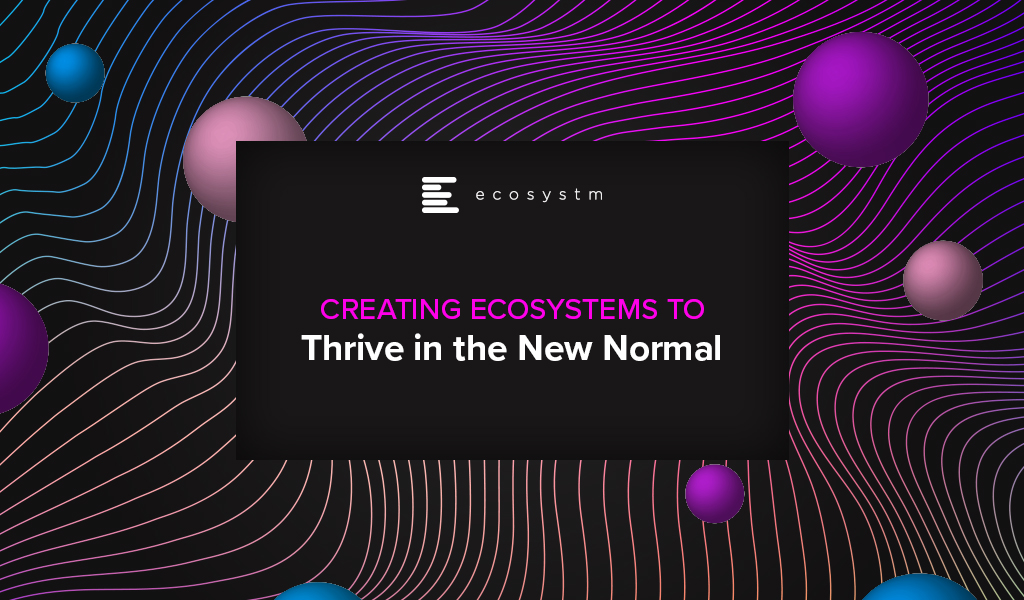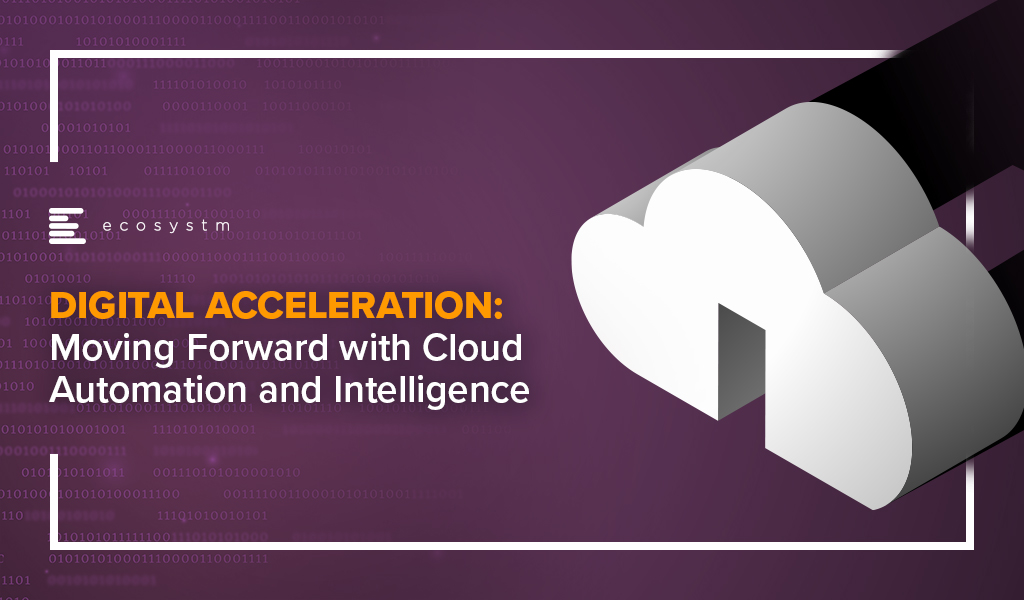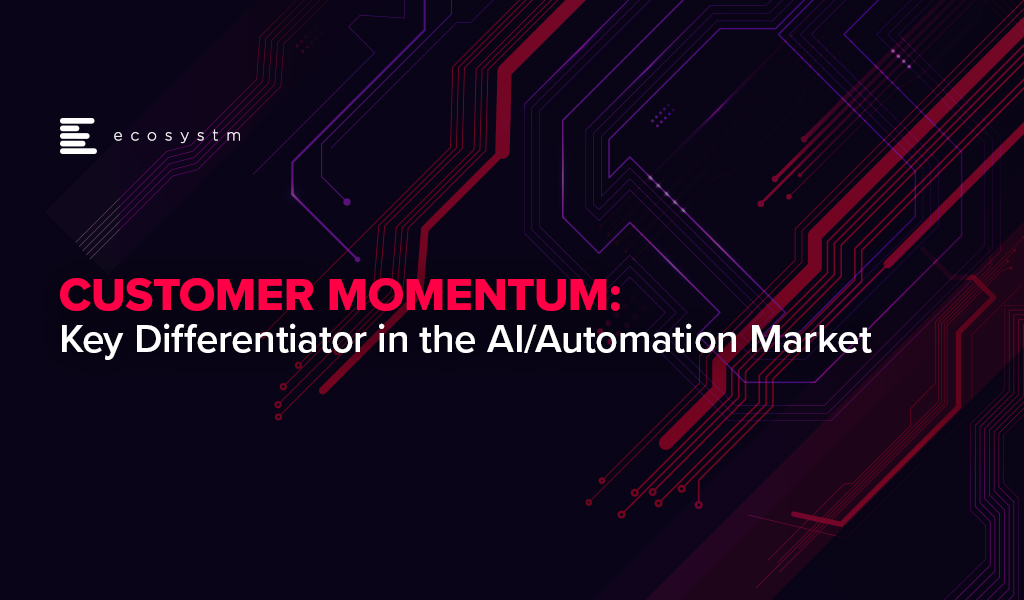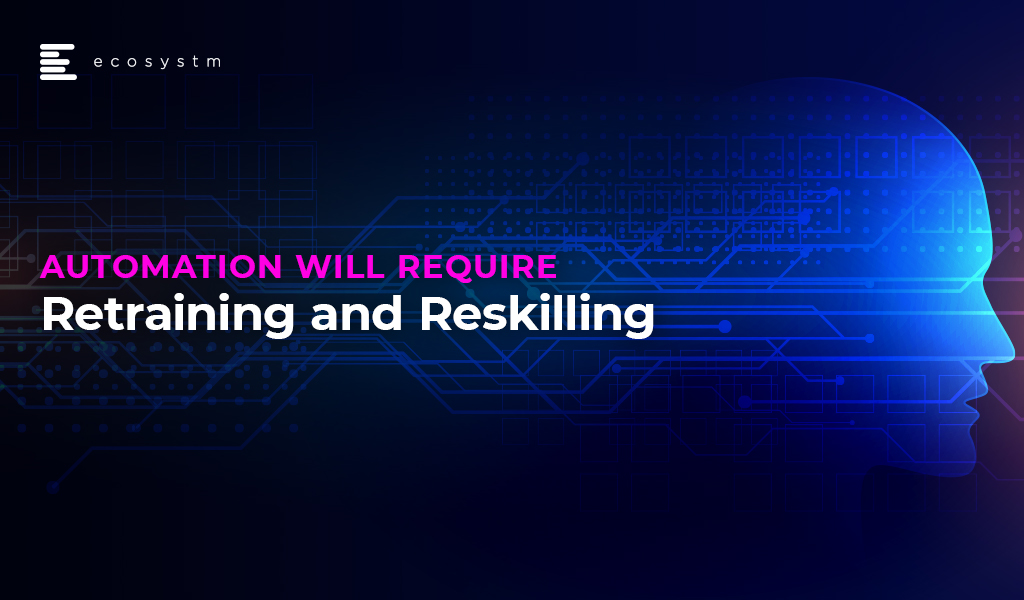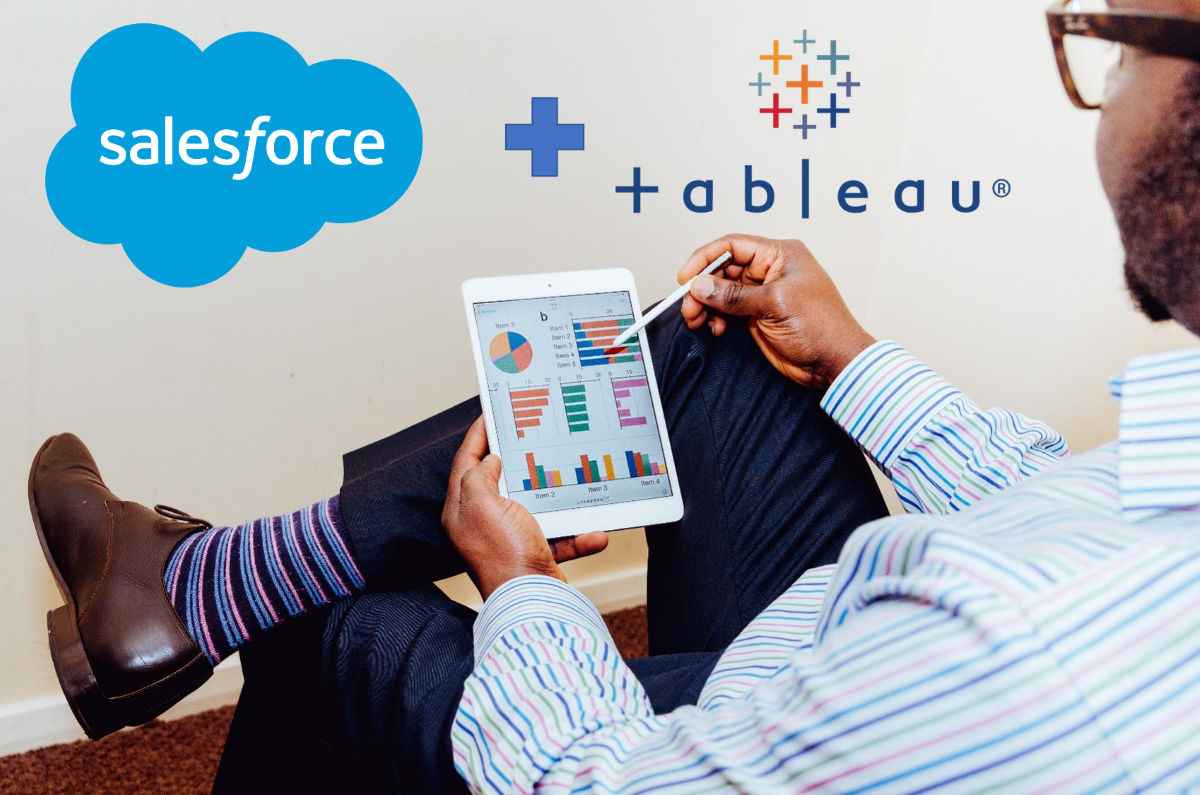A decade ago, the axiom of a successful business model was to identify a need, find the market and then develop an idea or product that fits into that chain. It was a process of inserting a product in the customer’s already existing experience journey with the hope that the product/idea would deliver efficiency to the client. This efficiency could be financial, operational, marketing or cost savings – the uni-product, uni-feature approach.
There has been enough said about the many companies that failed to innovate beyond their existing product/feature and failed to stay ahead of the game. Nokia and Blackberry remain at the centre of any discussion about “lack of innovation”. There are others like Kodak, Canon, Napster, Palm, Blockbuster – that were devoured by innovative competitors.
The predators were ones with the vision to see the entire value chain and not just their own product. Netflix created content and distributed it, Apple touched the lives of their customers in multiple ways and AirBnb provided accommodation inventory, choice and booking all in one. The new secret sauce is to provide the customer with an ecosystem and not a product!
The Need to Transform
Cut to the COVID era – there are many businesses facing the downturn and experiencing the “moments of truth” giving rise to a desperate attempt to innovate, transform, survive, and come out as the rising stars. Ecosystm research finds that 98% of organisations have re-evaluated their Transformation roadmap (Figure 1), while 75% have started, accelerated or refocused their DX initiatives.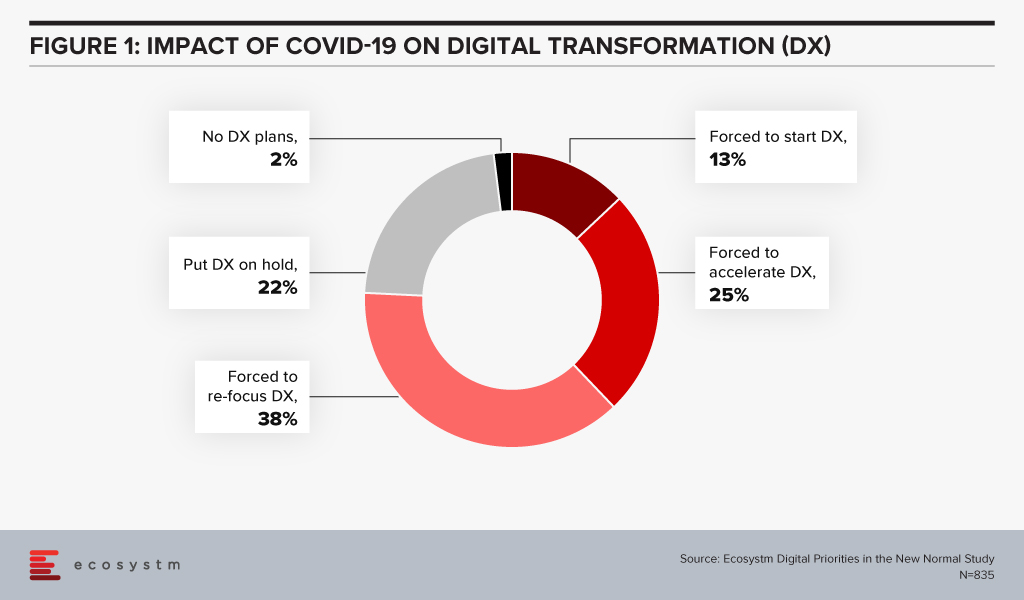
New business models are evolving, and accelerating digitalisation is the result. The digital movement, be it in food delivery or payments, is here to stay. This digital acceptance and absorption exaggerate the need for business models that capture holistic ecosystems and entire customer journeys, due to reasons that separate the hunter and the hunted.
- Margins will never be the same again as in the uni-product model. Using the F&B analogy; with the increasing number of customers wanting to dine in the comfort of their homes, restaurants cannot use ambiance as the price differentiator. Since most restaurants are available on food delivery services, customers are getting brand agnostic. This is the start of commoditisation of dining. Restaurants (or food caterers now!) will need to play the price card to remain competitive resulting in compressed margins. The food delivery market is expected to grow 4-fold to USD 8 billion by 2025 but with lower margins. This example of the food delivery model will be the same as experienced by retail, apparel and other industries.
- Customer experience will still be the differentiator and lever for loyalty and repeat purchase. Factors like proximity, parking, in-store experience, and store layout are fast getting replaced by the ease of navigation, user experience, seamless check out and finally efficient and timely delivery. The ease of transaction including multiple steps of search, assessment, evaluation, payment and delivery is of paramount importance. Customers do not want fractured journeys with multiple drop-offs. A unified seamless journey will win.
- Virtual, Digital and Automation are the three mantras that management consultants are betting on. However, this trilogy will not guarantee survival since the road to recovery is not a straight one. Different work schedules, observing various curves and on what point of the curve the business, its customer and the market are at, will add to the complexity of decision making and transformation.
Given the above, an obvious strategy to beat the existential crisis is to transform and seek out sustainable operating models. However, it may not be so simple since most businesses may not be able to change models as quickly as needed. There is an inherent cost to change since the existing processes and procedures have been well oiled and smoothed over time. The much-needed change requires the infusion of the 3Ts (time, technology, training) and associated costs. Most often, there is an inverse correlation noticed between the sturdiness of the business and its ability to be flexible to change. Businesses that are “rock-solid” and profitably sturdy and stable, have high inertia of transformation versus FinTech businesses, as an example, that pride themselves with nimble operations but are financially fragile and may not be able to absorb the cost of speedy transformation.
This Sturdy-Flexible continuum is the tight rope walk that businesses will need to walk in this need for transformation. Businesses that embark on this walk alone will find it extremely painful and lonely. Especially in the case of small business owners who are scared and low on all 3Ts.
The Rise of Ecosystems
The new world has manifested that businesses that use physical space or assets as their competitive advantage are more prone to be impacted. Retail, Education, Hospitality and Entertainment are some obvious examples that have been impacted by the physicality in their propositions. Digital businesses are more agile but have suffered in their inability to scale up in time to capture the increased demand.
Fashion retailer FJ Benjamin has decided to shut 300 physical stores and rely on online sales. This strategy also helps to utilise precious time to scale diversification. Other retailers too have been going down the FJ Benjamin path and ramping up eCommerce as this trend is expected to stick beyond COVID-19.
Zouk, the renowned nightclub with 30,000 square feet of space in Singapore uses this venue as a live streaming venue during the day to host bazaars for eCommerce vendors. From June 2020, it launched an online shop selling merchandise, bottled cocktails and food from its RedTail kitchen.
Transformation of businesses will require capabilities that were not created within their models. The instinct to survive in the short term will require businesses to create symbiotic partnerships. This will require some fresh thinking by business leaders.
- Change the “Build” obsession and not try to own every leg of the customer journey. That will not only take time but also distract capital and management.
- Rethink the customer needs – and this time think of the entire journey rather than an inward view of product-market fits. Customer needs are changing at breakneck speeds, so chasing and “building” these “fits” will always remain a common string amongst laggards.
- Connect with like-minded ecosystem players and complement strengths with a single-minded focus on solving customer problems.
- View technology stacks through the lens of your partners. There may be opportunities available from near open source technology solutions.
For example, FJ Benjamin will need the last-mile-delivery capability that will be provided by partners who have optimised in that field, Zouk has tied up with Lazada to host the bazaars and GrabFood is using underutilised taxi capacity to meet the increased demand for food delivery. There are many other examples in the O2O (Offline to Online) space.
This ecosystem approach is also relevant to other sectors like Financial Services. These firms also need to understand the changing consumer needs faster, with a mantra to deliver. Aspire, originally an alternate lending platform has gone through a metamorphosis and transformed into a Neobank. From a uni-product loan provider, it is now solving for a business account, card solution, integration with expense management solutions and continue to provide loans. Capabilities not necessarily built in-house.
The changing world will give rise to business models that will integrate and complement each other. Businesses with an ecosystem mindset will be winners while others might just be relegated to oblivion.

Focused on Digital Transformation? It is now more about how fast you can react to market shifts by using specific infrastructural resources.
This period is about digital acceleration. Cloud automation, artificial intelligence (AI), robotic process automation (RPA) and machine learning are all means to accelerate using infrastructure scalability.
Digital acceleration addresses the pace of change
Enterprises are searching to find unique and innovative ways to leverage cloud infrastructures with automation and intelligence. This is both to modernise and to optimise business processes while decreasing expenses. The speed at which the economic landscape has changed during the pandemic has removed debates on cloud usage:
- Remote work from home (WFH) with the need for video conferencing and collaboration tools has been supported by cloud
- Record amounts of SPAM and hacking attempts during the pandemic have leveraged cloud implementations for key security controls
- Tracking apps and classification and encryption of personally identifiable information (PII) via mobile devices are using cloud technology for greater automation and use of AI
Bandwidth and capacity are needed now. The ability to pivot, turn and shoot forward is critical to surviving and thriving in today’s radically changed marketplace. Cloud enablement can deliver enhanced customer experiences, monetise data assets, and can create new revenue streams by enabling new business models.
Cloud enablement explained
Digital acceleration is driven by cloud enablement, amplifying the enterprise value in the infrastructural investment.
Cloud enablement is an ongoing operational model. It incorporates orchestration, correctly organising teams, and a shift away from thinking only about platforms. The cloud platform is now a launchpad, not the main choice that has to be made. Orchestration is around the business and the business model, not just the technology.
Creating a cloud enablement strategic vision can identify where you need to go. It can provide the necessary requirements for expertise along the journey and deliver rapid, meaningful automation services engagements to deliver unbreakable delivery pipelines and agile cloud operations.
But this also involves managing and adjusting on the fly. Initial platform decisions, rolling out countless configuration changes and adjusting to new cloud investments make cloud enablement a tricky road to manage. Enterprises need to be cloud-smart towards their own business model and their strategy. Whatever configuration (on-prem, hybrid, private, public) combination works is dependent on many factors, including industry, size of the enterprise, employee resources and location.
The goal is implementing secure, flexible, scalable, and cost-effective cloud solutions. To do this requires regular cloud enablement audits as to the state of play and measuring successes.
Building and maintaining modern IT
Modern IT is hybrid and all the pieces that collect and manage the data need to be properly and securely managed. Just as technological (and economic) disruption has generally led to automation and the elimination of outdated processes, it has also always created new ideas and innovations.
One way to make your organisation more data-centric and digital is to selectively invest in those technology choices that are most adaptable and flexible to business needs. Data is the most strategic of assets and can be empowered by increasingly sophisticated intelligent operations. Process automation and AI help put that data to work by adding valued intelligence and encapsulating information.
Hybrid cloud coordination automated
Hybrid cloud coordination is an increasing enterprise demand, particularly in the Asia Pacific region, leading to enhanced data centres with joint customer support like the new Tokyo interconnection with Oracle and Microsoft Azure. The key to successfully monitoring a distributed cloud ecosystem is not only in gathering data on usage; it’s about knowing which questions to ask to make it more efficient and effective. This includes tracking connectivity speeds, creating common technical support and using single sign-on for better security. Here both AI and automation can help.
In Asia Pacific, the multi-cloud theme is being promoted heavily among integration providers with solutions that can plug into multiple clouds with virtual machine usage. Enterprises value enabled automated orchestration between cloud platforms. There will be a continued need for integrated tools across public and private clouds. This includes advanced analytics and AI as important aspects of an IT infrastructural investment.
Your choice of vendor for AI & Automation
In my opinion, AWS has the broadest AI service capabilities in the Asia Pacific cloud/ AI space, when compared to Microsoft, Google, and IBM. AWS provides users with pre-trained AI services for computer vision, language, recommendations, and forecasting to build, train, and deploy machine learning models at scale.
The Ecosystm VendorScope (Figure 1) rates the leading AI & Automation vendors in Asia Pacific based solely on quantifiable feedback from those who actually procure technology. It becomes clear from the responses that many organisations still start their AI journey through Automation. 
Most organisations understand the importance of leveraging AI to gain competitive advantage. But they do not necessarily know where to start. The secret is that AI is about intelligent process automation, and the firms who understand this are not the ones automating tasks. The use of RPA with vendors such as Antworks, WorkFusion, Arago and Automation Anywhere, leverages automated reasoning using knowledge-based problem-solving engines. These vendors add RPA to AI, not the other way around.
And domain-specific service providers have been creating the synergies for enterprises to link intelligent automation software and industry knowledge to create the necessary end-to-end workflows. An innate understanding of the specific business process is key to leveraging intelligent automation.
Focusing on developing a modern data supply chain process, with actionable analytics insights built into the infrastructure, can aid the development of self-service business intelligence capabilities along with visual data discovery solutions.
Cloud enablement solutions generate maximum business value by enabling IT with scalability and flexibility. This can reduce maintenance and security costs. A focus on cloud intelligence and scalability allows IT departments to concentrate more on innovative solutions, insights and systems that drive significant business growth. Now is the time, and speed is of the essence.
Ecosystm Vendorscope: AI & Automation
Sign up for Free to download the Ecosystm Vendorscope: AI & Automation report.

I’m really excited to launch our AI and Automation VendorScope! This new tool can help technology buyers understand which vendors are offering an exceptional customer experience, which ones have momentum and which are executing and delivering on their promised capabilities. The positioning of vendors in Ecosystm VendorScopes is independent of analyst bias or opinion or vendor influence – customers directly rate their suppliers in our ongoing market benchmarks and assessments.
The Evolution of the AI Market
The AI market has evolved significantly over the past few years. It has gone from a niche, poorly understood technology, to a mainstream one. Projects have moved from large, complex, moonshot-style “change the world” initiatives to small, focused capabilities that look to deliver value quickly. And they have moved from primarily internally focused projects to delivering value to customers and partners. Even the current pandemic is changing the lens of AI projects as 38% of the companies we benchmarked in Asia Pacific in the Ecosystm Business Pulse Study, are recalibrating their AI models for the significant change in trading conditions and customer circumstances.
Automation has changed too – from a heavily fragmented market with many specific – and often very simple tools – to comprehensive suites of automation capabilities. We are also beginning to see the use of machine learning within the automation platforms as this market matures and chases after the bigger automation opportunities where processes are not only simplified but removed through intelligent automation.
Cloud Platform Providers Continue to Lead
But what has changed little over the years is the dominance of the big cloud providers as the AI leaders. Azure, IBM and AWS continue to dominate customer mentions and intentions. And it is in customer mentions that the frontrunners in the VendorScope – Microsoft and IBM – set themselves apart. Not only are they important players today – but existing customers AND non-customers plan to use their services over the next 12-24 months. This gives them the market momentum over the other players. Even AWS and Google – the other two public cloud giants – who also have strong AI offerings – didn’t see the same proportions of customers and prospects planning to use their AI platforms and tools.
While Microsoft and IBM may have stolen the lead for now, they cannot expect the challengers to sit still. In the last few weeks alone we have seen several major launches of AI capabilities from some providers. And the Automation vendors are looking to new products and partnerships to take them forward.
Without the market momentum, Microsoft and IBM would still stand above the rest of the pack – just not as dramatically! Both companies are not just offering the AI building blocks, but also offer smart applications and services – this is possibly what sets them apart in an era where more and more customers want their applications to be smart out-of-the-box (or out-of-the-cloud). The appetite for long, expensive AI projects is waning – fast time to value will win deals today.
The biggest change in AI over the next few years will hopefully be more buyers demanding that their applications are smart out-of-the-box/cloud. AI and Automation shouldn’t be expensive add-ons – they should form the core of smart applications – applications that work for the business and for the customer. Applications that will deliver the next generation of employee and customer experiences.
Ecosystm Vendorscope: AI & Automation
Signup for Free to access the Ecosystm Vendorscope: AI & Automation report.

There has been a widespread adoption of hybrid and multi-cloud architectures in the recent past and this trend is only expected to go up in the near future. A hybrid cloud adoption has its challenges though; including the need for organisations to baseline their security practices across so many different environments. Organisations that are aware of the cybersecurity risks associated are increasingly looking for external specialised help in managing their cloud security measures, especially with an aim to automate the processes.
Zscaler Acquires CloudNeeti
In a recent announcement, Zscaler announced its intentions to acquire Cloudneeti, a niche Cloud Security Posture Management (CSPM) start-up based in Redmond, Washington. This is set to expand Zscaler’s Cloud Security Platform capabilities to include data protection. With this acquisition, Zscaler will be able to complement its own offerings to provide:
- A complete Data Protection and Exposure Prevention suite, that works across locations, users and applications and ensures better compliance with regulations
- A Unified Compliance Assurance platform that provides compliance visibility and breach mitigation across the multiple SaaS applications an organisation uses
- Risk Reduction through automated remediations following both industry compliance laws and organisations’ own risk management program guidelines
Ecosystm research finds that organisations are struggling with their cybersecurity implementations, especially as the solutions get increasingly complicated to combat the complex and evolving threat environment (Figure 1). Integration with existing cybersecurity measures, and a lack of sufficiently skilled IT staff to handle the myriad needs of the multiple systems and applications, builds a strong case for automation in cybersecurity practices.

Ecosystm Principal Advisor, Alex Woerndle says, “Automation is critical in cybersecurity, given the volume of data, alerts and incidents that are being dealt with on a daily basis, globally. Automating recurrent and high-volume tasks is a critical step in getting on top of this challenge.”
Importance of Automating Cybersecurity Processes
Woerndle sees a growing role for CSPM providers for multiple reasons. “Firstly, a lot of companies are finding that they cannot be ‘fully cloud’ and as such, end up with a complex architecture spanning on-premise, private cloud environments and multiple public cloud tenancies. Secondly, due to poorly planned cloud migrations, changing priorities, differences in service requirements, cost differences and also personal preferences across multiple teams, a lot of companies end up consuming different services across multiple public cloud providers (Azure, AWS, GCP, and so on). IT teams are struggling to be experts in all aspects of the shared responsibility model and with the capabilities to secure the various services. Finally, there is a constant stream of upgrades and addition of new services team members, given the easy accessibility public cloud environments provide. CSPM solutions provide the ability to establish baselines, enforce security controls and run regular checks to ensure compliance. Doing this manually is time consuming, expensive and always three steps behind.”
Woerndle also sees further complications because of the COVID-19 crisis. “COVID-19 has shifted the world to remote working overnight. Once workers are outside of the trusted corporate network and have access to cloud resources from their home networks, additional complexity to the corporate security posture is highlighted. Depending on how organisations have prepared for this, they either maintain control of all services and applications, and the access into each, or if not prepared, open direct access to a lot of unsecured applications from potentially very unsecured networks.” In fact Zscaler has seen its stock prices rising in the aftermath of the global crisis.
However, Woerndle warns, “While the conversation certainly supports the use of CSPMs, there is a lot more to it in terms of securing home networks, identity and access management, and so on.”
Zscaler’s acquisition of CloudNeeti certainly appears to be a timely move, in the current environment when organisations are struggling with a lack of resources with the extensive knowledge to understand all private and public cloud environments. There are controls required to secure each application, resource and system within an organisation – along with the time and effort required to implement, monitor, audit and improve cybersecurity measures over time.
Having recently taken a security awareness course as part of my annual requirement by my organization, I was thinking about how other assets (besides people) also tasked with roles in the business can better protect the corporate environment. This led to thoughts about the role of the smart building in deterring cyber-attacks. An organization’s information risk profile is defined through a risk assessment of organizational information infrastructure and associated data assets.
So how might the infrastructure of a smart building decrease your organizational risk profile? Can you measure this?
In terms of having an index, I am currently creating an index (like my security awareness course) to rate the level of cybersecurity a building provides to its owners (or lessees). Given we already have sustainability indices for commercial real estate in the form of the CBRE Green Building Adoption Index, my intention is to build a reference cybersecurity metric in how the infrastructure of smart buildings can be compared from the point of those either owning or renting the space. For this index, I will be defining the number of risks, type of risk and potential effects of risk on smart building infrastructural implementations.
Separating control from performance
Physical control of buildings was traditionally seen as separate from enterprise networks. The control systems domain was protected by physical separation, and facilities management was handled as a different domain. However, as global services delivery, data sharing and data acquisition for cost-effectiveness became critical functions within modern business, facilities management became tied to the corporate data network.
Smart buildings now combine legacy operational technology for building automation systems (BAS) together with enterprise IT and IoT devices. Unlike IT environments, which have developed workflows and technologies to address cyber threats, hackers can exploit the vulnerabilities of BAS to enter the IT network and get hold of restricted data located on servers and computers.
The benefits of operation and analytics available for facilities management on how the building performed have given insights into better asset management. But with connectivity has come risk exposure to external exploits and possible attacks.
Life at the Edge
Given edge computing and IoT devices create content for analysis, can they also provide misinformation or redirection for potential attacks on the corporate network? In other words, can the smart building dangle a click bait carrot or honey trap for potential hackers to pull them off the scent of the main system?
Just as we have access layers of data security based on roles within the enterprise, perhaps we should start looking at creating a separate operational data layer for physical control of the building, with the building taking an active role in its own defense. IoT technology, such as sensors, can automatically transfer an office area to ‘vacant’ security mode so potential hackers cannot gain access by moving the area to preset security settings to optimize network protection. This could also mean terminals off, USB ports disabled, and access secured with physical tokens.
Design to cloak or protect
Another way we can create a buffer to protect those assets by a slight disconnect with better perimeter management. One recent approach is the concept of Airwalls. Tempered Networks defines their Airwall edge services as “identity-defined perimeters that enforce access and segmentation for the systems protected within the Airwall”. This creates the possibility to deploy end-to-end encrypted connectivity around operational assets. An Airwall controls and enforces authenticated network communications between protected systems, while denying access to all unauthorized systems. To my understanding, authorized devices for protected access would be physical objects, not passwords. The goal is to remove the access to the IP address information for the potential hacker by creating an air pocket within the enterprise. For those Star Trek fans reading this, imagine a Klingon cloaking device for the ICS.
From the point of standards, there is the development of the IEC 62443 global set of cybersecurity standards to reduce vulnerability. This is set to improve safety, availability, integrity and confidentiality of systems used for industrial automation and control.
How much risk exists from your operational BAC systems?
Smart buildings can be efficient and effective but can also come with cybersecurity vulnerabilities that can be inadvertently introduced when smart technologies are deployed without the necessary consideration of what controls and patches are required to protect them.
In your cybersecurity planning for 2020, what active role does your operational systems play both in protection and in deterrence? Is your smart building helpful with sensor usage and alerts, or does it create hacking opportunities with disconnects and older communication protocols?
Reach out to have a conversation with me if you are interested in the index I am working on, or you’d like some advice on what cyber risk issues to consider in your infrastructural development.
As technology continues to permeate all aspects of business and influence how employees execute their roles, there is a growing need for more technologically proficient employees to quickly become future-ready. To enable this, organisations need to develop strategies and support parameters to reskill and upskill their workers.
Why the Need to Retrain and Reskill
Retraining and reskilling are nothing new, and industries have witnessed it several times in the past. The Industrial Revolution replaced many workers with mechanised tools and machinery. Workers who embraced change, and learned how to use the machines, replaced those who did not or could not. It is true that every new technology creates its own turbulence. What is unique this time is that the shift is happening faster as technology advances exponentially. So, people need to retrain and upskill quicker if they are to keep pace with the changing technology landscape.
Both manual and cognitive tasks are being empowered by machines and AI algorithms. There is also a shortage of a skilled workforce with the right technical training. Here is why the need for technological skills has increased exponentially over the last few years:
Productivity. Organisations are looking for ways to increase productivity and are spending time on identifying technologies that can help them compete in the future. The introduction of AI and automation is replacing legacy systems and displacing positions such as junior executives, administrative staff, customer service executives and so on. Chatbots and novel interactive robotic companions are offering better productivity with an ability to work 24×7 without taking breaks and can be updated and taught new skills with some minor changes in their algorithm. To understand and to work on AI and chatbot queries, employees require special training and skills. For instance, in a customer care team, if a chatbot is not able to respond to a query it can then be passed to a customer service executive who is able to work in tandem with the AI tool to solve the query.
Profitability. The primary reason why organisations look to technology-driven automation is to create an impact on their profit margin. While making the investment in the technology often requires an upfront cost, once the systems are in place there is a positive impact on productivity and hence more profits. Organisations should ideally invest part of the profits to implement more advanced technology and upskilling their current employees. The lower productivity workers often add up to the costs and reskilling them can save money and lead to more seamless workforce integration. For instance, Fintech is being used increasingly to automate decisions such as instant loan approval, KYC, fraud detection and other financial crimes. This does not remove the need for subject matter experts and those that have experience and expertise in the domain – they can train those automated systems by feeding queries, analysing outputs and helping the organisation improve their automated process.
Avoiding being Obsolete. In this digital era, even individuals possessing decades of work experience might get outdated if they do not keep pace with an evolving landscape. Lacking an ability to understand and empathise with technology is often a consequence of improper training. Employees require training at regular intervals – if they do not have the expertise and cannot give the right feedback to these automated systems, there might be serious consequences. As an example, most organisations planning to procure software will also evaluate SaaS solutions. This requires employees to be flexible to adapt to the Cloud environment and to look beyond the legacy systems that they are comfortable with.
Mergers and Acquisitions. In today’s competitive market, we witness mergers and acquisitions almost on a daily basis, with organisations wanting to gain skills, services, technology and ultimately market share. When a company is bought or merges with another, along with a change in leadership and organisational culture, there is also a change in technology used. If organisations want to retain the expertise of the newly acquired firm, retraining becomes essential. In these new set-ups, what will matter more than seniority is the ability of the employees to adapt to and learn the new technologies.
Being Competitive. Technology is seen as an enabler for business differentiation. Increasingly the twin focus areas for all organisations are customer experience (CX) and employee experience (EX) – how to retain and win both customers and employees. When it comes to outperforming the competition, the technology used for the eCommerce platform, point-of-sale solution, back-office operations – virtually every part of the operation, can be a key component of the overall competitive edge. Having workers that are properly trained in the technology they use, and those who buy into the organisational culture will be a crucial advantage in this competitive world.
How to incorporate retraining and reskilling in your Transformation Journey
Organisations should follow best practices when embarking on reskilling initiatives, in order to rapidly drive ROI. It is always a good idea to invest in people who are invested in your organisation. Amit Gupta, CEO, Ecosystm interviewed Parry Singh, Chief Commercial & Digital Officer, Mediacorp where they discussed how emerging technologies such as AI, are impacting the media industry, how to carry an organisation through the digital transformation journey and how to upskill employees for the future. The key takeaways for organisations looking to retain their valuable staff are:
- Realise that learning is a continuous process. Companies should analyse technologies that will impact their business and their industry. But should also be aware that these technologies will evolve continually. To handle this learning should also be continuous. Walmart, for instance, has set up more than 100 “academies” in the US that provide continual classroom and hands-on training for various positions. Having the right talent in place is critical to the prospects of any organisation.
- Make arrangements for just-in-time learning. Learning works best when people can apply their new-found knowledge and skills almost immediately. Organisations should identify the skills that employees will need in their immediate role. This also helps employees appreciate the value of the training and be open to future upskilling. NUS Business School offers a 3-day course, Leveraging Fintech for Business aimed at leaders and managers, to explore the business impact of Fintech – aimed at entrepreneurs and mid-career financial professionals who wish to upskill and those who are impacted by Fintech. Organisations can provide employees with on-demand learning tools and resources. Tools like mobile apps and online courses can help employees to learn and grow and allow them to engage with the program at their convenience and at their own pace instead of forcing them to adhere to a pre-planned schedule.
- Partner if you do not have the right training process. An organisation cannot always be expected to have the right training resources available in-house – it might also prove to be expensive in the long run. Organisations that lack expertise or do not have enough resources to train and reskill employees, should partner with technology providers and dedicated external training programs. SkillsFuture in Singapore has partnered with IBM to train 2,500 Singaporeans on AI skills within the next three years, in a bid to help them apply AI in areas such as human resources, supply chain management, and media.
Technology-enabled automation will displace some workers while at the same time provide a platform for them to grow their careers and play a larger part in the success of the organisations. Companies can enable this transition through investments in training and education and provide a platform for workers to transition to new jobs. With the right tools, companies can continue to forge a long-term and mutually beneficial association with their employees in the face of rapid and increasing digital transformation.
I recently attended a briefing with Ramco Systems – if you haven’t heard of them, they are one of an emerging group of software vendors who are challenging the big application software companies – SAP and Oracle. They put innovation at the centre of their business – aiming to constantly drive improvement for their customers, and bringing companies the benefits of systems that consumers see in their web-based and mobile apps but have been sorely missing from the enterprise application market. To be honest they are a breath of fresh air in a market that needs it – and their endeavours are seeing results both in plaudits from analyst firms and new customer wins.
At the briefing, Ramco demonstrated some of the AI capabilities they have been weaving into their software platforms. And in doing so they have shown the gap between today’s systems and systems that actually work for their clients. ERP, HR, Payroll and other enterprise applications are data sinks – they demand constant input, and while they do a good job in automating business processes, they could do so much more.
Within Ramco they have moved away from email completely for employee inquiries – all interactions now happen with their transactional chatbot, including scheduling meetings, checking leave balances, discovering and understanding personal achievements, raising a travel request and claiming travel expenses – as well as understanding company policies and supporting employees with speculative queries. This same bot is available for clients as they aim towards a zero-UI interface – no more logging onto systems and interrogating applications, running searches. Now you ask a question and get an answer – using an IM client or a voice interface (such as Google Home or Amazon Alexa devices). This is the way systems should serve employees.
Like other enterprise application vendors, they have added an AI capability to their platform – but they are taking the extra step to make that AI work out of the box (or the cloud). For example, with all the information in your HR systems (employee skills, time and attendance, incentives, expenses, payroll) they are looking at making that information accessible and actionable for potential users – creating systems that understand the context and anticipate needs.
In your finance or ordering systems, they are applying machine learning so it understands that ‘client A’ tends to order specific items from specific locations – so ordering agents are guided towards those options versus having to scroll through long lists.
(see images for an example of that in the process)
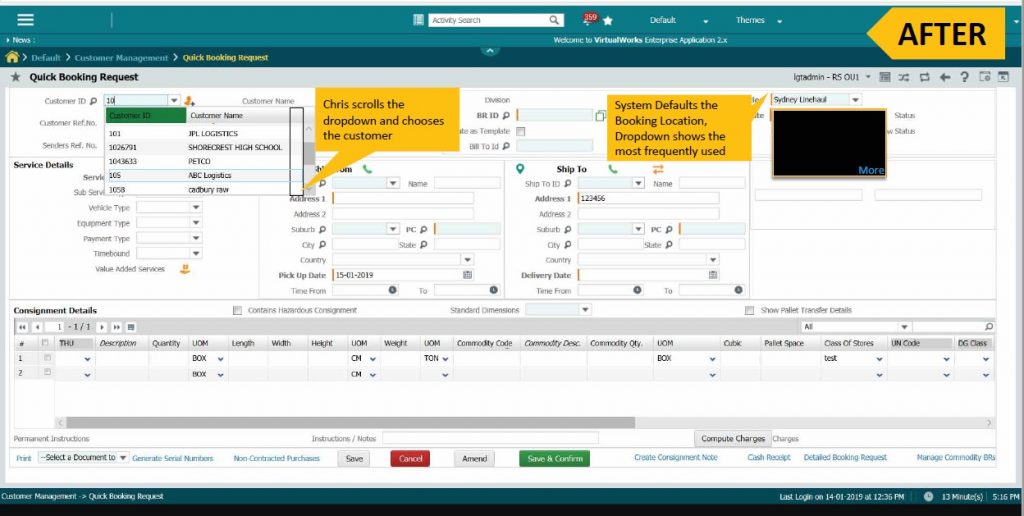
They are recommending where costs should be allocated or validating inputs based on historical learnings. The systems can catch a mistake, errors or even fraud – saving the business significant amounts of money and of time in error correction or re-work.

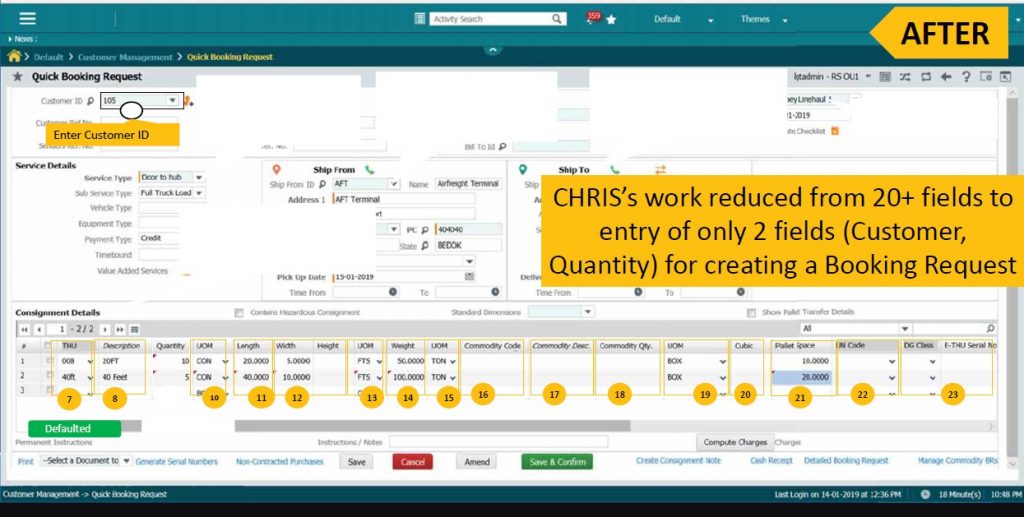
Ramco’s vision is that agents only have to manage exceptions in enterprise applications – not every single detail. Complete automation is still an unrealistic expectation, but businesses should aim for 85% automation, with 12% of processes needing intervention for mild intervention and 3% needing deep intervention. In Ecosystm’s experience speaking to businesses that have automated to such a degree, an 85% automation does NOT lead to an 85% saving – as you typically automate the easier cases anyway. But the savings should be real and measurable – up to 50% time saving for accounts receivable or payable teams, for payroll teams, for help desks or for other highly manual processes should be achievable.
And while the business case can be built on the saving, the pay-off also comes in happier and more engaged employees who have the information right at their fingertips to make better business decisions or drive smarter business processes.
So why highlight Ramco’s AI capabilities? For a number of reasons:
- For AI to be widely adopted, it needs to be easy and accessible – Many other vendors (the big cloud players in particular) are making AI tools and assets available for customers, but they still have to do the hard work – find a business problem, gather the data, train the algorithm, deploy the algorithm and then train users on the new process. There are hundreds – or even thousands of examples of processes in business that can be made smarter and easier through the use of machine learning and AI – and vendors should be building these capabilities into the products and platforms. Ramco is doing that – they are by no means alone – but they are a good example of a software vendor that is disrupting a market by focusing on helping their customer succeed.
- I believe there is a bigger trend going on in the way businesses buy software (and look out for an upcoming report on this topic). More and more I see businesses adopt the best solution for their needs – NOT the one that does 80% of what they want. And the best software is often built by smaller, more agile companies. They build for specific business needs and specific niches – and they focus on providing exactly what customers want. I am seeing a general move away from the big platform providers towards the smaller ISVs. Partly because they cost less (I regularly hear companies say they saved up to 90% by using a specialist provider!) – but also because they provide the best solution – and businesses can no longer compromise when it comes to driving the best customer and employee experiences. Again, Ramco is a part of this change.
You should demand more from your applications provider – an AI platform is not enough. They need to make your actual application smart – they need to be able to automate processes you are already doing. If you have data the system should be able to learn, they need to focus on making the system work for you, your employees and your customers – not the other way around (as is too often the case). AI needs to be a core component of your business applications, not a bolt-on.
In a move that feels “back to the future”, Salesforce has agreed to acquire Tableau Software Inc for US$15.3 billion in a deal that is expected to close in the third quarter of 2019. It seems all independent BI and analytics companies (except SAS!) eventually get snapped up – Business Objects by SAP, Hyperion by Oracle, Cognos by IBM. The move comes less than a week after Google acquired BI and analytics provider Looker.
Today, many businesses use Tableau (over 86,000), including a lot of Salesforce customers. They have chosen Tableau because it is easy to deploy and use, and like Salesforce own applications, it targets the ultimate decision maker – the business user – and sometimes even the consumer. Recent research into the BI systems integrators in Asia Pacific shows that Tableau is one of the leading analytics platforms for the partner community in the region – the big SIs have many people focused on Tableau. But that dominance is being challenged by a re-energised Microsoft, whose Power BI is also witnessing strong growth – and who is typically the price leader in the market.
For Salesforce customers, there is some overlap between products – their own Einstein Analytics tools do much of what Tableau can do – although Tableau helps customers see insights from data stored both on the cloud and inside their own data centres. It also moves Salesforce closer to the Customer 360 vision – the ability to get a view of customers across the Commerce, Marketing and Service Clouds. Salesforce customers not using Tableau today will get a better user experience by using Tableau as the visualisation platform.
History has shown that it is hard to make such acquisitions successful. Tableau was a huge success because it was independent. The same was for Business Objects and Cognos before their acquisitions. History has shown that when the large BI and analytics vendors are acquired, others move into that space. While Salesforce has announced they will run Tableau as a separate business, it will no longer be independent. Partners will need to be maintained and provided a growth path – and partners are the cornerstone of Tableau’s success. Some of these partners might have strong ties to other software or cloud platforms too such as SAP, Oracle, AWS or Google. Customers of Tableau might feel sales pressure to move to a Salesforce environment – and will likely see Salesforce integration happen at a deeper level than on other platforms.
Tableau’s independence will disappear. However keeping Tableau as a separate business may not be the long term goal for Salesforce – it might be to offer the best application and analytics solution in the market – to make the entire suite more attractive to more potential buyers and users. It may be to take Salesforce beyond the current users in their customers to many other users who may not need the full application but need the analytics and visualisations that the data can provide. If this is the case, then the company is onto a winner with the Tableau acquisition.
BUT…
The long term goal is not analytics reports delivered to employees. It is not visualisation. It is automation. It is applications doing smart, AI-driven analysis, and deciding for employees. It is about taking the human out of the process. In a factory you don’t need a report to tell you a machine is down – you need to book a repair person automatically – or a service technician to visit before the machine has even broken down. And you don’t need a visualised report to show that a machine is beyond its life expectancy. You need the machine replaced before it fails catastrophically.
Too often, we are putting humans in processes where they are not required. We are making visualisations more attractive and easier to consume when, in reality, we just needed the task automated. While we employ humans, there will be a need to make decisions more effectively, and we will still require tools like Tableau. But don’t let the pretty pictures distract you from the main prize – intelligent automation.
If you would like to speak to Tim Sheedy or another analyst at Ecosystm about what the acquisition Tableau by Salesforce might mean to your business or industry, please feel free to schedule an inquiry call on the profile page.
I ran several roundtables over the past few weeks speaking to business and technology leaders about their AI investments – and one factor came up many times – that it is hard to build a business case for AI because 70% accuracy was not good enough…
What this means is that companies have thousands of things to automate. Most of those automations in the short-medium term will deliver 100% accuracy using RPA and other simple automation tools. Every time you run that process you know the outcome.
Along Comes AI and Machine Learning
These dumb processes can now learn – they can be smart. But originally they won’t deliver 100% accuracy. They might only deliver 60-70% to start with – climbing perhaps to 90%. The benefits of these smart, learning processes can amaze – costs can fall, processes can improve, outcomes can accelerate. But traditionally we have built technology business cases delivering 100% accuracy and outcomes.
So we need a new way to think about AI and a different language to use about the way it works. The people who sign off on the business cases might not understand AI – they will come to the business case with the same lens they use for all technology investments (and evidently – all business investments). We also need to be better at selling the benefits to our leaders. CEOs and Managing Directors in the roundtables are surprised to hear that AI won’t deliver 100% accuracy – they said unless they know more about the capability, savings and outcomes that the solution might drive, they are unlikely to fund it.
Make Your Dumb Processes Smart
I take this as good news. It means we have moved beyond the hype of AI – the need to “do AI in our business” that drove many of the poorer chatbots and machine learning projects. It means that businesses review AI investments in the same way as any business investment. But it also means we can’t over-promise or under-deliver on AI. Woodside did this with their initial foray into AI, and they are still playing catch up today.
While there are many opportunities to use “dumb automation” and save money, reduce or redeploy headcount – or have employees focus on higher value activities or make real differences to customer experiences – there are as many opportunities to make dumb processes smart. Being able to automatically read PDF or paper-based invoices – processes usually done by humans – could be a huge saving for your business. OK – maybe you can’t redeploy 100% of the staff, but 70% is still a big saving. Being able to take human error out of processes will often help to save money at two steps on the process – automating the human input function up front and also getting rid of the need to fix the mistake.
Start Your AI Journey With The Low Hanging Fruit
Ecosystm’s Global Ongoing AI study has shown that most businesses are focusing their AI investments on internal initiatives – on reducing process time, cost savings and driving productivity – which makes the most sense today. They are the easier business cases to build and the easiest benefits to explain.
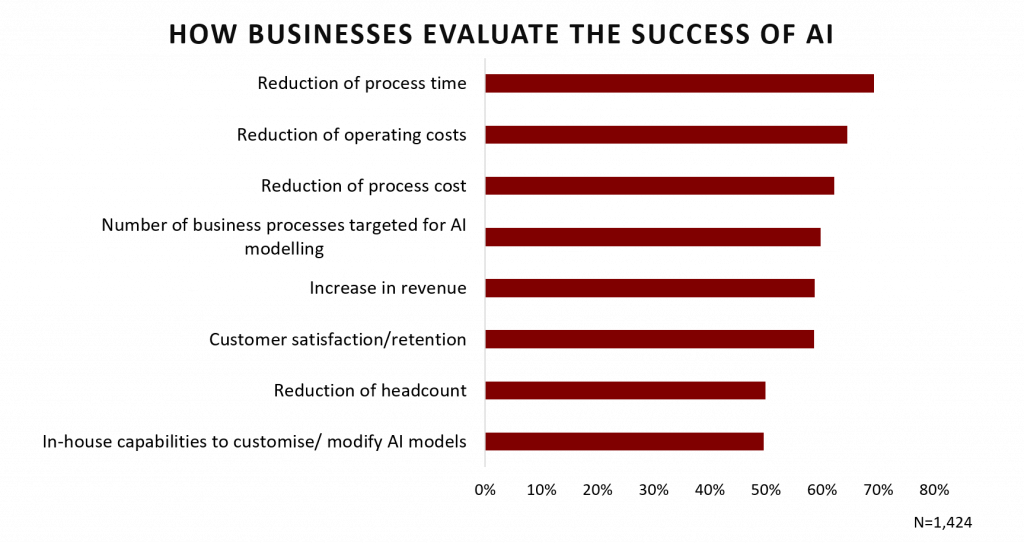
Perhaps AI is also a chance for businesses to acknowledge that “efficient” does not always mean “good”. Many of the processes we automated or coded to ensure 100% compliance don’t give customers or employees what they are looking for. And maybe making the customer happy 70% of the time is better than not making them happy at all…
If you’d like to dig deeper into Ecosystm’s reports exploring the data from our ongoing AI study – check them out here (you’ll need to register if you have not already – it is free to register, but some content is premium):
4 Vendors Emerge as Leaders: Understanding the AI Vendor landscape
Use Cases Drive AI Software Adoption: Understanding The Industry Landscape


